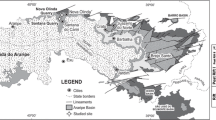Abstract
The occurrences of sepiolite beds and nodules in alkaline and saline Miocene Eskisehir lake deposits provide unique examples of ancient lacustrine environments. Stockwork-type magnesite deposits, which were formed very close to the Miocene lake, served as parent rocks for sepiolite nodules (meerschaum). The Miocene succession consists of calcareous clay, clayey carbonate, dolomite, a gypsum-bearing calcareous clay series, siliceous tuffs, sepiolite beds, sepiolite-bearing dolomite, and basal conglomerates of ultramafic rocks. Sepiolite beds were deposited by direct precipitation from Si-supersaturated lake water under alkaline and saline conditions. They are underlain by a gypsum series. Organic matter-rich sepiolites suggest the presence of water stratification with anoxic bottom waters, which developed due to high sulphate input at the base from the ascending hydrothermal solutions along the fracture systems with extensive fresh water input near to the surface. Sepiolite nodules resulted from diagenetic replacement of magnesite pebbles at shallow burial under alkaline conditions in the vicinity of paleo-shorelines. Sepiolite beds were deposited in three ways: 1) black (up to 2.8 wt. % TOC) sepiolite beds rich in organic matter accumulated in an anaerobic paleoenvironment; 2) brown (about 0.5 wt. % TOC) sepiolite beds poor in organic matter, containing minor amounts of white, 2–6 mm long, discontinuous, and very soft dolomite laminae formed in a dysaerobic paleoenvironment; and 3) white dolomitic sepiolite beds in which dolomite content is about 20–40% in an aerobic paleoenvironment.
Cyclic dolomite and gypsum series indicate hypersaline-evaporative paleoenvironments with rapid changes in lake water chemistry. These cyclic evaporatic conditions are also related to cyclic changes in water depth. Based on X-ray powder diffraction data, except degree of crystallinity, no minéralogie difference was found between sepiolite in beds and nodules. SEM studies revealed fibers about 0.2 µm wide and up to 30 µm long in sepiolite beds; crystals less than 5 µm long with bent tips; and a more compacted appearance in sepiolite nodules.
Similar content being viewed by others
References
Abtahi, Al. (1977) Effect of saline and alkaline ground water on soil genesis in semi-arid Southern Iran: Soil Sci. Amer. J. 41, 583–588.
Akinci, Ö. (1967) Eskişehir I24-cl Paftasinin Jeolojisi ve Tabakali Lütetasi Zuhurlari: M.T.A. Dergisi. Bull. of Min. Res. Exp. Inst, of Turkey 67, 82–97.
Fleischer, P. (1972) Sepiolite associated with Miocene diatomite, Santa Cruz basin, California: Amer. Mineral. 57, 903–913.
Folk, R. L. and Siedlecka, A. (1974) The “schizohaline” environment: Its sedimentary and diagenetic fabrics as exemplified by late paleozoic rocks of Bear Island, Svalbard: Sedimentary Geol. 11, 1–15.
Folk, R. L. and Land, L. S. (1975) Mg/Ca ratios and salinity: Two controls over crystallization of dolomite: Bull. Amer. Assoc. Petrol. Geol. 59, 60–68.
Galan, E. and Ferrero, A. (1982) Palygorskite-Sepiolite Clays of Lebrija, Southern Spain: Clays & Clay Minerals 30, 191–199.
Gibbs, R. J. (1965) Error due to segregation in quantitative clay mineral X-ray diffraction mounting techniques: Amer. Mineral. 50, 741–751.
Gibbs, R. L. (1968) Clay mineral mounting techniques for X-ray diffraction analysis: A discussion: J. Sediment. Petrol. 38, 242–244.
Hewett, D. F. (1956) Geology and mineral resources of the Wanpal Quadrangle, California and Nevada: U.S. Geol. Survey Prof. Paper 275, 143–144.
Jackson, M. L. (1975) Soil Chemical Analysis—Advanced Course: 2nd ed., published by the author, Madison, Wisconsin, 895 pp.
Jones, B. F. and Galan, E. (1988) Sepiolite and palygorskite: in Hydrous Phyllosilicales (Exclusive of Micas), S. W. Bailey, ed., Reviews in Mineralogy, Mineralogical Society of America 19, 631–674.
Krauskopf, K. B. (1956) Dissolution and precipitation of silica at low temperatures: Geochim. Cosmochim. Ada 10, 1–26.
Kulaksiz, S. (1981) Siwihisar Kuzey-Bati Yöresinin Jeolojisi: Hacettepe Univ. Yerbilimleri 8, 103–124.
Longman, M.W. (1980) Carbonate diagenetic textures from nearshore diagenetic environments: Bull. Am. Assoc. Petrol. Geol. 64, 461–487.
Otsuka, R., Manko, T., and Sakamoto, T. (1973) Mineralogische Eigenschaften vom Meerschaum von Eskisehir, Turkei: in Memoirs of the School of Science & Engineering, Waseda Univ. Japan 37, 43–52.
Post, J. L. (1978) Sepiolite deposits of the Las Vagas, Nevada, area: Clays & Clay Minerals 26, 58–64.
Shadfan, H., Mashhady, A. S., Dixon, J. B., and Hussen, A. A. (1985) Palygorskite from tertiary formation of Eastern Saudi Arabia: Clays & Clay Minerals 33, 451–457.
Singer, A. (1984) Pedogenic palygorskite in the arid environment: in Palygorskite-Sepiolite: Occurrences, Genesis and Uses, A. Singer and E. Galan, ed.., Elsevier, Amsterdam, 169–175.
Velde, B. (1985) Clay Minerals: A Physico-Chemical Exploration of Their Occurrence: Elsevier, Amsterdam, 225–256.
Wey, B. and Siffert, B. (1961) Reaction de la silice monomo-leculaire en solution avec les ions Al, Mg. Genese et Synthese des Argiles: Colloq. Int. C.N.R.S. 105, 11–23.
Weaver, C. E. and Beck, K. C. (1977) Miocene of the S.E. United States: A model for chemical sedimentation in a peri-marine environment: Sedimentary Geol. 17, 201–225.
Williams, L. A. and Crerar, D. A. (1985) Silica diagenesis: II. general mechanisms: J. Sediment. Petrol. 55, 312–321.
Wollast, R., Mackenzie, F. T., and Bricker, O. (1968) Experimental precipitation and genesis of sepiolite at earth-surface conditions: Amer. Mineral. 53, 1645–1662.
Yeniyol, M. and Öztunali, Ö. (1985) Yunak Sepiolitinin Mineralojisi ve Olusumu. II. Ulusal Kil Sempozyumu Bildiriler: Hacettepe Univ., Ankara, 24–27.
Yeniyol, M. (1986) Vein-like sepiolite occurrence as a replacement of magnesite in Konya, Turkey: Clays & Clay Minerals 34, 353–356.
Yariv, S. and Cross, H. (1979) Geochemistry of Colloid Systems: Springer-Verlag, Berlin, 405 pp.
Author information
Authors and Affiliations
Rights and permissions
About this article
Cite this article
Ece, Ö.I., Çoban, F. Geology, Occurrence, and Genesis of Eskişehir Sepiolites, Turkey. Clays Clay Miner. 42, 81–92 (1994). https://doi.org/10.1346/CCMN.1994.0420111
Received:
Accepted:
Published:
Issue Date:
DOI: https://doi.org/10.1346/CCMN.1994.0420111



